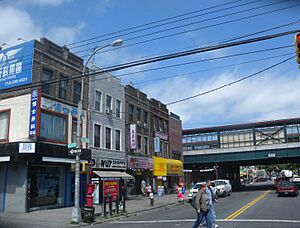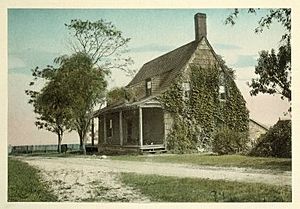Avenue U facts for kids

Avenue U at East 15th Street, in the developing Avenue U Chinatown. The Brighton Line station is in the background.
|
|
| Owner | City of New York |
|---|---|
| Maintained by | NYCDOT |
| Location | Brooklyn, New York City |
| West end | Stillwell Avenue in Gravesend |
| East end | Bergen Avenue at Bergen Beach |
| North | Avenue T |
| South | Avenue V |
Avenue U is a busy street in Brooklyn, New York City. It's a main road that stretches across a large part of Brooklyn. Avenue U starts at Stillwell Avenue in Gravesend. It then goes all the way to Bergen Avenue in Bergen Beach. Along the way, it passes through neighborhoods like Gravesend, Homecrest, Sheepshead Bay, Marine Park, and Mill Basin.
Contents
Avenue U's Chinatown
Avenue U in Homecrest is home to southern Brooklyn's second Chinatown. You can see this by the many Chinese food markets, bakeries, and restaurants. There are also beauty and nail salons, and stores selling computers and electronics. These businesses are mostly found between Coney Island Avenue and Ocean Avenue.
Since 2004, the Q train on the BMT Brighton Line has made it easy to travel. It connects Canal Street in Manhattan's Chinatown directly to Brooklyn's Avenue U Chinatown. Another Chinatown has also grown in southern Brooklyn, in Bensonhurst. It is served by the D train subway line.
This Chinatown on Avenue U is like a second branch of Manhattan's Chinatown. The first branch in Brooklyn grew in Sunset Park. In just sixteen years, the number of Chinese people living in Brooklyn grew a lot. As property prices went up and areas became crowded in Sunset Park's Chinatown, more Chinese people moved. They started moving into the Sheepshead Bay and Homecrest areas in the late 1990s. This led to the creation of the second Chinatown on Avenue U.
The Avenue U Chinatown is still growing. It started small, covering less than ten blocks. This was similar to how Manhattan's Chinatown began in the late 1800s and early 1900s. Back then, Manhattan's Chinatown was focused on a small area of Mott, Doyers, and Pell Streets.
Chinese residents call Avenue U "U大道" (U Dàdào) in Chinese. They call Sheepshead Bay "羊头湾" (Yángtóuwān). Just outside this Chinese area, there is a Chinese supermarket called New York Mart. The East West Bank is a major Chinese bank that serves the Avenue U Chinatown.
This new Chinese community, along with parts of Bensonhurst, is mostly made up of Cantonese speakers. These areas are like extensions of the Cantonese part of Manhattan's Chinatown. Even though these Brooklyn areas together are now bigger Cantonese cultural centers than Manhattan's Chinatown, Avenue U's Cantonese community is still the smallest. Bensonhurst, however, is now the largest Cantonese cultural center in New York City. There are also smaller numbers of people who speak Fuzhou and Mandarin. Some Vietnamese Chinese residents are also part of the community.
People and Cultures on Avenue U

People from China have become the second largest group of foreign-born residents in New York City. As of 2016, about 11% of New York City's population, or 350,000 people, were born in China. China was the largest source of immigrants within Brooklyn. Chinese immigrants made up about 14% of Brooklyn's population, totaling about 129,000 people. Bensonhurst alone had about 78,000 of these immigrants. This means more than half of Bensonhurst's population was born outside the U.S. The Avenue U Chinatown has the fastest growing Chinese population in all of New York City. From 1990 to 2000, the number of people living on Avenue U increased by 16-30%.
Even though Avenue U in Brooklyn has a large Chinese population, the street shows many other cultures too. You can clearly see the Cantonese influence in the shops and restaurants. But you will also find Italian, Mexican, Russian, Vietnamese, and Uzbek markets and restaurants.
Over time, Avenue U has welcomed many different groups of immigrants. It has been home to Jewish, Irish, and Italian people. Later, Russian, Chinese, and Mexican immigrants moved there. With each new group, the street's culture changes and grows.
Many middle-class immigrants live in Gravesend, one of the areas Avenue U goes through. As of 2008, these immigrants often pay over $600,000 to live near their family members. Jewish, Irish, and Italian families make up most of the Sephardic community. At the same time, Chinese, Mexican, Russian, and Yugoslavian immigrants also live in Gravesend.
Getting Around: Transportation on Avenue U
There are three New York City Subway stations in Brooklyn named Avenue U:
- The Avenue U station (BMT Brighton Line) is served by the Q train train.
- The Avenue U station (IND Culver Line) is served by the F <F> trains train.
- The Avenue U station (BMT Sea Beach Line) is served by the N W trains train.
Bus service on Avenue U is provided by these routes:
- The B3 bus runs along almost the entire length of Avenue U. It does not run between 86th Street and Stillwell Avenue, or between East 71st Street and Bergen Avenue. East 71st Street is where this bus route ends.
- The B47 bus runs on the avenue between Mill Avenue and East 54th Street. This is near Kings Plaza, where the route finishes.
- The B100 bus runs between Mill Avenue and East 66th Street.
- The BM1 express bus runs between East 71st Street and East 66th Street.

